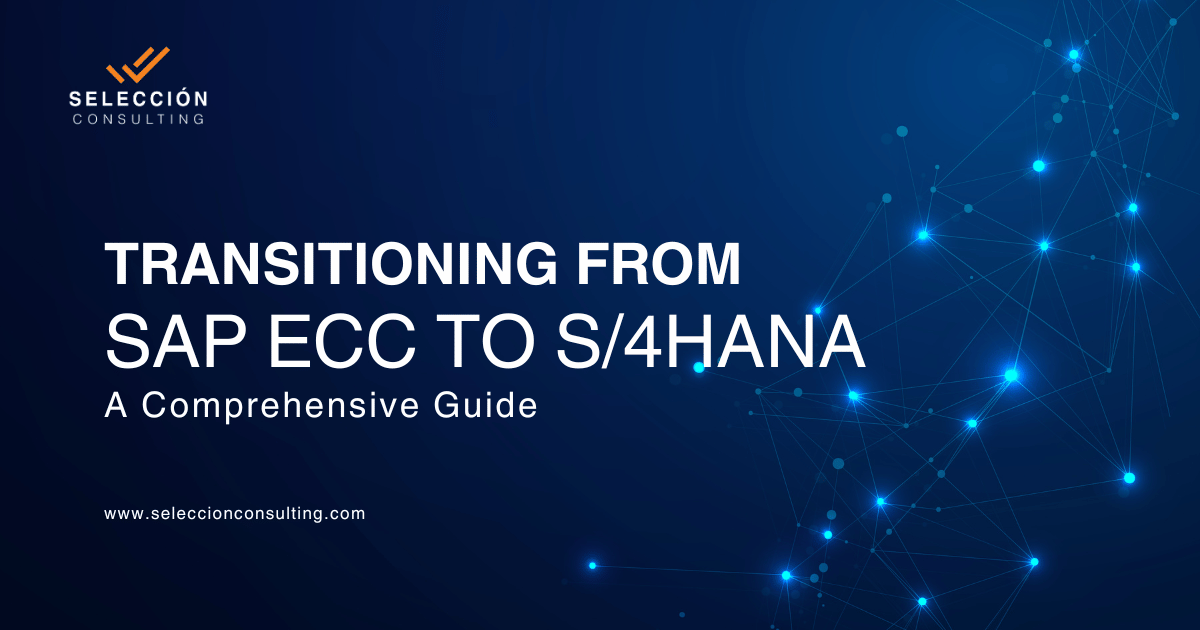SAP ECC to S/4HANA Migration: A Step-by-Step Guide

In today’s rapidly evolving digital landscape, businesses are continually seeking ways to enhance efficiency, streamline processes, and unlock new opportunities for growth. With SAP announcing the end of support for ECC by 2027, organizations still running on ECC need to start planning their transition to SAP S/4HANA sooner rather than later. In this comprehensive guide, we’ll explore the process of converting from, providing a detailed step-by-step roadmap for a successful migration.
SAP S/4HANA and Its Significance in the Digital Transformation Journey:
In today’s rapidly evolving business landscape, organizations are increasingly turning to digital transformation to stay competitive and drive growth. At the heart of this transformation journey lies SAP S/4HANA, an intelligent, next-generation ERP (Enterprise Resource Planning) suite developed by SAP SE.
SAP S/4HANA represents a quantum leap forward in enterprise software, offering a host of advanced features and capabilities designed to meet the demands of the digital age. Unlike its predecessor, SAP ECC, which relied on traditional relational databases, S/4HANA leverages cutting-edge in-memory computing technology powered by the SAP HANA platform.
The Key Differences between SAP ECC and SAP S/4HANA:
SAP ECC (Enterprise Central Component) and SAP S/4HANA are both ERP solutions developed by SAP, but they differ significantly in terms of architecture, functionality, and capabilities.
Architecture:
SAP ECC is built on a traditional relational database system, which can be limiting in terms of data processing speed and real-time analytics.
SAP S/4HANA, on the other hand, is built on an advanced in-memory database called SAP HANA. This allows for lightning-fast data processing and real-time insights, enabling organizations to make quicker and more informed decisions.
Functionality:
SAP ECC offers a comprehensive suite of ERP modules covering various business functions such as finance, procurement, manufacturing, sales, and distribution.
SAP S/4HANA builds upon this functionality but also introduces new capabilities such as embedded analytics, machine learning, and predictive analytics. It offers a more streamlined and intuitive user experience, with simplified processes and fewer manual interventions.
Data Model:
SAP ECC follows a traditional row-based data storage model, which can lead to redundant data and slower performance.
SAP S/4HANA utilizes a columnar data storage model, which allows for more efficient data compression and faster data retrieval. This results in reduced data footprint and improved system performance.
User Interface:
SAP ECC uses the SAP GUI (Graphical User Interface), which can be complex and cumbersome for users.
SAP S/4HANA features a modern and intuitive user interface, with role-based Fiori apps that provide users with personalized and context-sensitive access to relevant information and tasks.
In summary, SAP S/4HANA represents a significant evolution from SAP ECC, offering enhanced performance, functionality, and user experience.
Why Organizations Need to Migrate to SAP S/4HANA:
End of Support for SAP ECC:
SAP has announced that it will end support for SAP ECC by 2027, which means organizations will no longer receive updates, patches, or bug fixes. Migrating to SAP S/4HANA ensures ongoing support and access to the latest innovations from SAP.
Digital Transformation:
SAP S/4HANA is designed to support digital transformation initiatives, enabling organizations to leverage emerging technologies such as AI, IoT, and blockchain to drive innovation and stay competitive in the digital age.
Real-Time Insights:
With its in-memory computing capabilities, SAP S/4HANA provides real-time insights into business operations, allowing organizations to make faster and more informed decisions.
Simplified Processes:
SAP S/4HANA streamlines business processes, eliminates redundancies, and reduces complexity, resulting in increased efficiency and productivity.
Scalability and Flexibility:
SAP S/4HANA is designed to scale with the needs of growing organizations, providing the flexibility to adapt to changing business requirements and market conditions.
In essence, migrating to SAP S/4HANA is not just an IT upgrade but a strategic business decision that can drive growth, innovation, and competitive advantage.
Step-by-Step Guide to SAP S/4HANA Transition:
1. Assessment and Planning:
Before embarking on the transition journey, it’s essential to conduct a comprehensive assessment of your current ECC landscape. Evaluate your existing business processes, customizations, and dependencies to develop a migration plan tailored to your organization’s needs. Determine key milestones, timelines, and resources required for a successful transition.
2. Preparing the System:
Prepare your ECC system for conversion by ensuring it meets the necessary prerequisites for transitioning to S/4HANA. This may involve applying required support packages, performing system upgrades, and addressing any technical requirements specific to the migration process. System readiness is crucial for a smooth transition to S/4HANA.
3. Data Migration and Validation:
Data migration is a critical aspect of the transition process, ensuring that essential business data is seamlessly transferred from ECC to S/4HANA. Utilize migration tools and methodologies to extract, transform, and load data into the new system. Validate the integrity and accuracy of migrated data through rigorous testing and validation processes to minimize disruptions post-migration.
4. Custom Code Adaptation and Testing:
Evaluate existing custom code and enhancements in your ECC system to ensure compatibility with S/4HANA. Adapt and optimize custom code to align with the new data model and architecture of S/4HANA. Conduct thorough testing to validate custom code functionality and mitigate any potential issues that may arise during the transition.
5. Training and User Adoption:
Empower your team with the necessary skills and knowledge to effectively navigate the new S/4HANA environment. Provide comprehensive training programs and user documentation to facilitate a smooth transition and foster user adoption. Engage stakeholders early in the process to address any concerns and ensure a seamless transition experience.
6. Go-Live and Post-Migration Support:
Execute the migration plan and go live with the new S/4HANA system according to the established timelines. Monitor system performance closely post-migration and provide ongoing support to address any issues or challenges that may arise. Regularly assess the system’s performance and make necessary adjustments to optimize its functionality.
Common Challenges and Considerations in the Transition Process:
While the benefits of transitioning to SAP S/4HANA are clear, the transition process itself can be complex and challenging. Common challenges include data migration, custom code adaptation, business process reengineering, training, and user adoption. Organizations need to carefully plan and execute their transition strategy, taking into account these challenges and considerations to ensure a smooth and successful migration to SAP S/4HANA.
Conclusion:
In conclusion, the conversion from SAP ECC to SAP S/4HANA is a complex and multifaceted process that requires careful planning, execution, and support. By following the step-by-step guide outlined above, businesses can navigate the migration journey successfully and unlock the full potential of SAP S/4HANA.
At SELECCIÓN Consulting, we specialize in guiding organizations through the SAP ECC to S/4HANA conversion process, providing expert consulting services, and supporting every step of the way. Contact us today to learn more about how we can help you achieve a seamless migration to SAP S/4HANA and drive business transformation.
